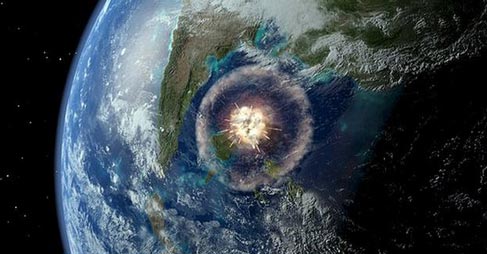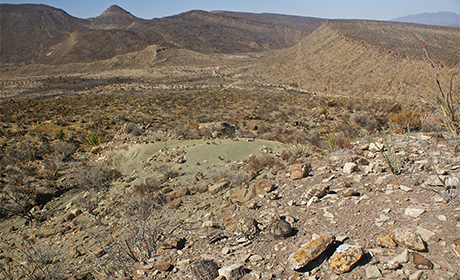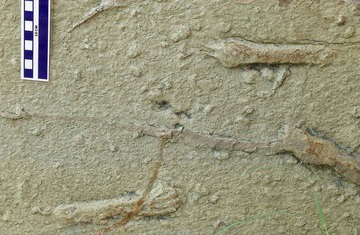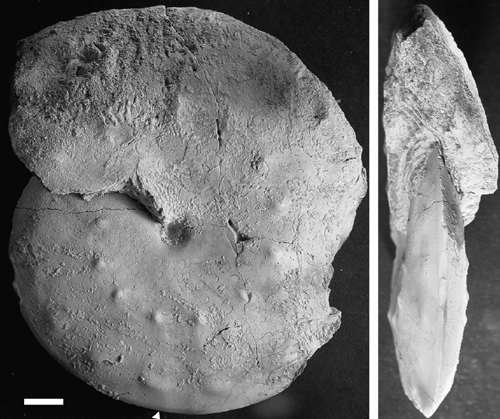Chicxulub Impact Event Not Responsible for Dinosaur Extinction
Mexican Tracksites Indicate Decline of Dinosaurs Prior to Impact Event
A team of scientists based in Germany and Mexico have published a paper that challenges the commonly held belief that the extraterrestrial impact event marked by the Chicxulub crater resulted in the extinction of the dinosaurs and their flying cousins the pterosaurs. In addition, studies of marine sediments indicate that at least one species of ammonite Sphenodiscus pleurisepta may have survived into the Palaeogene.
Chicxulub Extraterrestrial Impact Not the Cause of Global Mass Extinctions
Exploring the Fossil Assemblage of the Cretaceous/Palaeogene Boundary
Writing in the journal of the “Geological Society of America Bulletin”, the researchers which include lead author Professor Wolfgang Stinnesbeck of Heidelberg University, Professor Eberhard Frey (State Museum of Natural History, Karlsruhe) and scientists from the Museo del Desierto, Coahuila, (Mexico), postulate that the dinosaurs and the flying reptiles were in long-term decline before the Chicxulub impact and the global mass extinction that marked the end of the Mesozoic.
The scientists also postulate that Aves (birds), had spread and diversified at the same time as the Dinosauria was in decline. Furthermore, based on fossil evidence, the team contend that at least one type of ammonite, Sphenodiscus pleurisepta persisted into the Cenozoic.
These conclusions were drawn from a comprehensive study of upper Cretaceous sedimentary sandstone rocks, laid down at the very end of the “Age of Dinosaurs”. The tracks and body fossils found at two localities in the Mexican state of Coahuila, depict life on the shore and the surrounding waters of a shrinking inland sea. Both sites represent sandstones within the Las Encinas Formation of north-eastern Mexico.
Remote Fossil Site in North-eastern Mexico (Las Encinas Formation)
Picture credit: Professor Stinnesbeck/Heidelberg University
The trackway assemblages at Amargos and Rancho San Francisco respectively, were produced by at least six different types of birds, while trackways of azhdarchoid pterosaurs are rare. Only a single footprint made by a dinosaur (Theropod) was recorded.
Professor Stinnesbeck commented:
“Dinosaur tracks, however, are rare. Only a single footprint comes from a predatory dinosaur.”
Lack of Pterosaur Fossil Evidence
The scarcity of pterosaur fossils was also noted. The scientists state that azhdarchoid pterosaur fossils are rare. Azhdarchids include some of the most famous and largest pterosaurs of all – Quetzalcoatlus Hatzegopteryx and Arambourgiania. Most of the Pterosauria had become extinct by the Maastrichtian faunal stage of the Late Cretaceous. From their heyday in the Early Cretaceous when at least ten pterosaur families existed, by the very end of the Cretaceous only two families of pterosaur are known in the fossil record.
Pterosaur Fossils Such as These Tracks are Very Rare
Picture credit: Professor Stinnesbeck/Heidelberg University
The photograph above shows prints of Azhdharchidea pterosaurs in a sandstone of the Upper Cretaceous, location – Rancho San Francisco near Paredon, north-eastern Mexico.
Research into the two locations Amargos and Rancho San Francisco, indicate a gradual decline of the dinosaurs with a simultaneous increase in the diversity of birds even before the end of the Cretaceous.
Professor Stinnesbeck added:
“Until now, it was generally assumed that the dinosaurs died out first and bird species diversified afterwards. Our data, however, substantiate the theory that birds ascended before dinosaurs became extinct.”
The team postulate that the extraterrestrial impact event was not the cause of the dinosaur and pterosaur extinction, these reptiles were already on their way out, long before that event took place. This idea of only a few dinosaur species persisting until the very end of the Mesozoic has been proposed before. A count of dinosaur fossils found in the famous Hell Creek Formation of Montana supported the theory that the Dinosauria were already in decline by the end of the Cretaceous, the fossil assemblage in the very youngest rocks was dominated by just a handful of species.
Ammonites Survived into the Cenozoic
In the scientific paper, the researchers comment that the ammonites were not wiped out by the asteroid/comet/meteor strike. Professor Stinnesbeck and his colleagues suggest that the species Sphenodiscus pleurisepta, a type of ammonite known from the United States and Mexico, survived, albeit in a declining state into the Palaeogene.
The geology professor stated:
“The effects of the Chicxulub impact were therefore not the cause of a global mass extinction, which probably came about considerably less catastrophically than previously assumed.”
Studying the Chicxulub Impact Event
The power of the extraterrestrial impact is evidenced by the abundance of crystalline clay minerals that are rounded in shape (smectite spherules), within a two-and-a-half metre-thick layer of strata.
The Last Ammonite (Sphenodiscus pleurisepta)?
Picture credit: Conrad
The picture above shows a typical fossil of S. pleurisepta (picture of the holotype fossil), scale bar equals 1 cm.
For models and replicas of ammonites and other prehistoric animals: CollectA Prehistoric Life Figures.
The fifty million year decline of the Dinosauria: Bayesian Analysis Sheds New Light on Dinosaur Decline.
To read about other ammonites that may have persisted into the Cenozoic: Unravelling an Ammonite Mystery.





